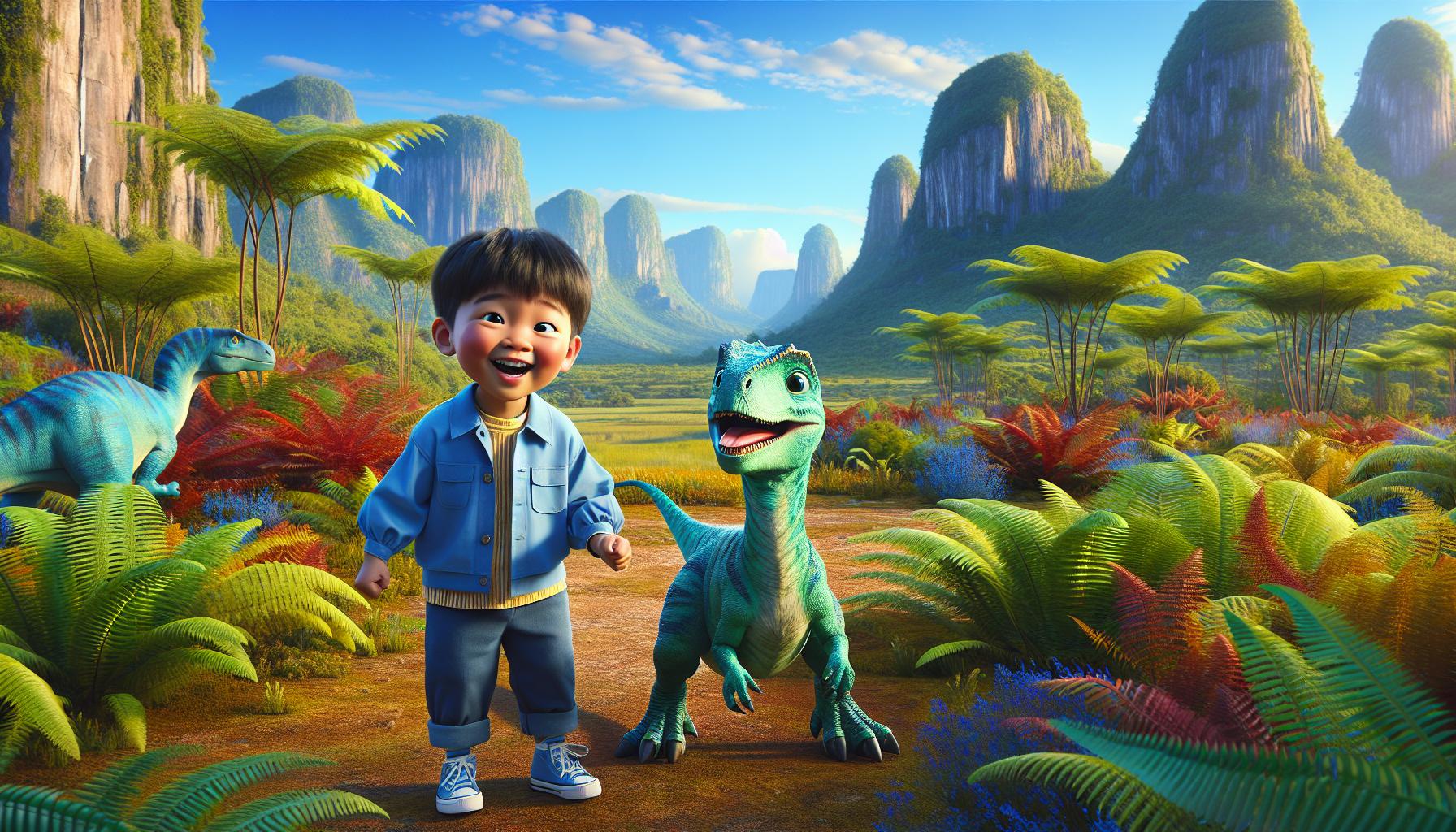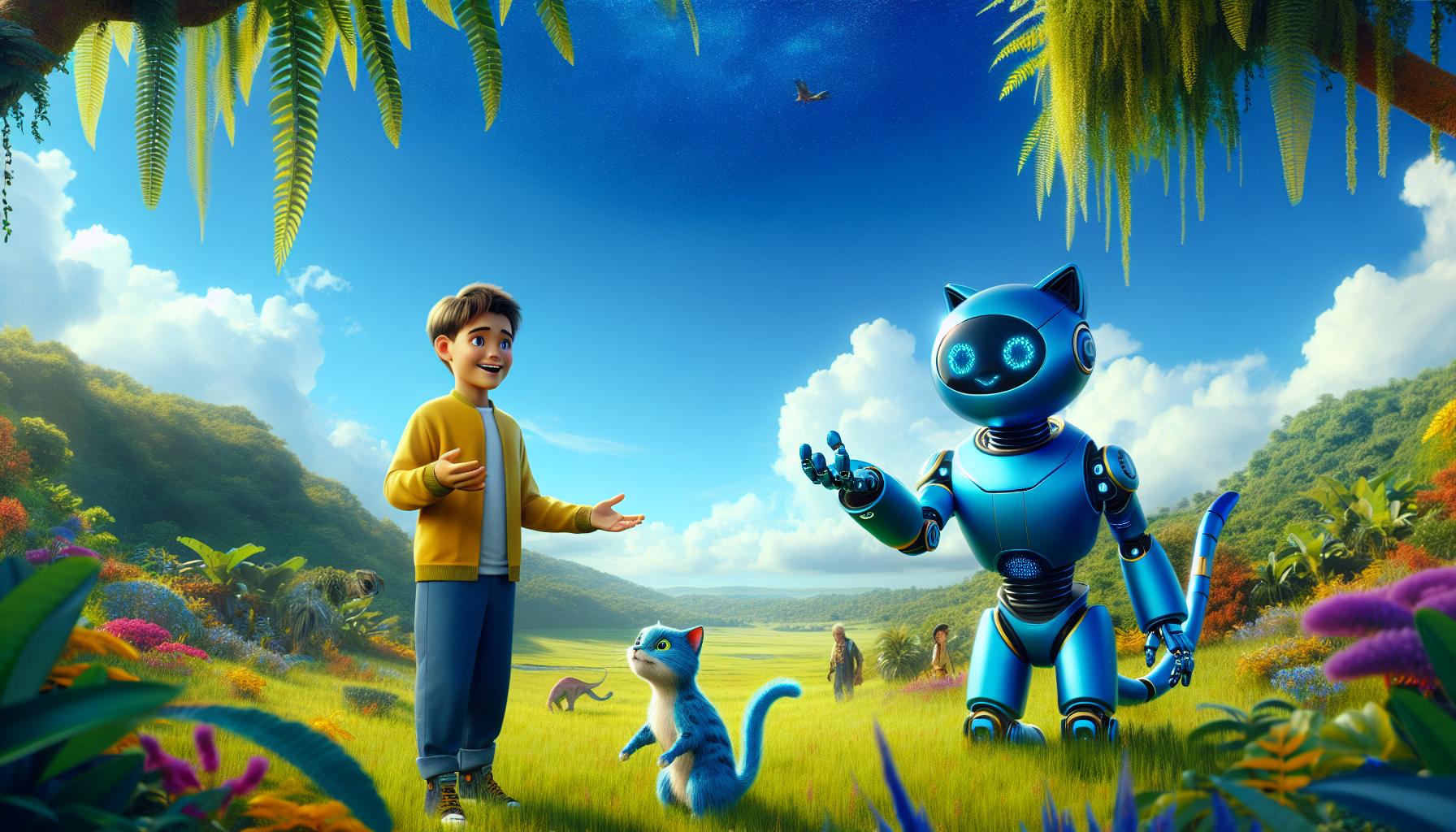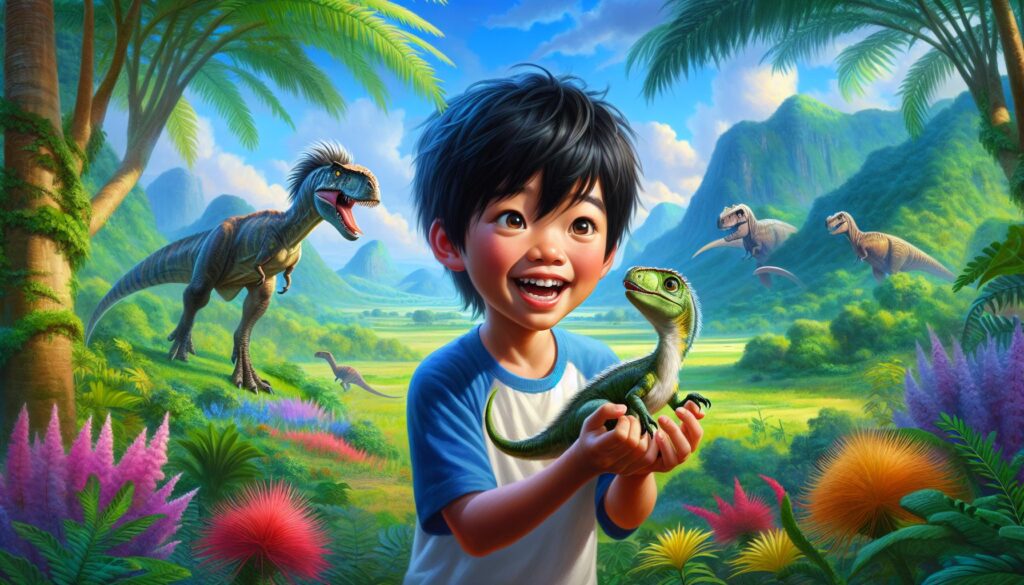As a lifelong fan of the Doraemon series, I’m thrilled to dive into one of its most captivating adventures: Doraemon: Chú Khủng Long của Nobita (Doraemon: Nobita’s Dinosaur). This beloved anime film takes us on a prehistoric journey filled with friendship, time travel, and of course, adorable dinosaurs.
In this heartwarming tale, Nobita discovers a mysterious egg that hatches into a baby dinosaur. With Doraemon’s help, they embark on a thrilling quest to return the dinosaur to its rightful era. Along the way, they face numerous challenges and learn valuable lessons about responsibility and the importance of preserving nature.
Key Takeaways
- “Doraemon: Nobita’s Dinosaur” is a beloved animated film that combines time travel, friendship, and prehistoric adventure.
- The story follows Nobita and Doraemon as they help a baby dinosaur named Piisuke return to the Cretaceous period.
- The film explores themes of responsibility, environmental conservation, and the consequences of one’s actions.
- With its unique blend of futuristic technology and prehistoric settings, the movie stands out among other Doraemon films.
- The enduring popularity of “Nobita’s Dinosaur” is evident through its multiple remakes and significant cultural impact in Japan and beyond.
Doraemon: Chú Khủng Long Của Nobita
“Doraemon: Nobita’s Dinosaur” is a beloved animated film in the Doraemon franchise, originally released in Japan in 1980. It’s the first feature-length Doraemon movie, setting the stage for a long-running series of annual films. The story revolves around Nobita, a young boy who discovers a mysterious egg that hatches into a baby dinosaur.
The film’s plot centers on Nobita and Doraemon’s efforts to return the dinosaur, named Piisuke, to its original time period. Using Doraemon’s futuristic gadgets, they embark on a thrilling adventure through time, facing numerous challenges and learning valuable lessons along the way.
Key elements of the movie include:
- Time travel: Doraemon’s signature gadget, the Time Machine, plays a crucial role
- Friendship: The bond between Nobita and Piisuke forms the emotional core of the story
- Environmental themes: The film touches on issues of conservation and human impact on nature
- Sci-fi elements: Futuristic technology from Doraemon’s pocket blends with prehistoric settings
“Doraemon: Nobita’s Dinosaur” has been remade twice, in 2006 and 2020, demonstrating its enduring popularity. Each version updates the animation style and adds new elements while maintaining the core story that captivated audiences in the original release.
Plot Overview

“Doraemon: Nobita’s Dinosaur” follows Nobita’s journey after discovering a mysterious egg that hatches into a baby dinosaur. The plot unfolds as Nobita and Doraemon embark on a time-traveling adventure to return the dinosaur to its rightful era.
Nobita’s Discovery
Nobita stumbles upon a peculiar egg while exploring a construction site near his home. The egg, much larger than any he’s seen before, soon hatches into a baby dinosaur he names Piisuke. Nobita’s initial excitement quickly turns to concern as he realizes the challenges of keeping a rapidly growing dinosaur in modern-day Tokyo. With Doraemon’s help, they create a temporary habitat for Piisuke using futuristic gadgets, but it becomes clear that a more permanent solution is necessary.
The Adventure Begins
Armed with Doraemon’s Time Machine, Nobita and his friends set out to return Piisuke to the Cretaceous period. Their journey takes unexpected turns as they navigate the dangers of prehistoric Earth. They encounter various dinosaur species, from massive herbivores to fierce predators, and face natural disasters like volcanic eruptions. Throughout their quest, the group learns valuable lessons about teamwork, courage, and the delicate balance of ecosystems. As they search for a safe place for Piisuke, they must also outwit a group of time-traveling poachers intent on capturing rare prehistoric creatures for profit.
Main Characters

The beloved characters in “Doraemon: Nobita’s Dinosaur” bring the story to life with their unique personalities and interactions. Here’s a closer look at the main characters and supporting cast that make this adventure so memorable.
Doraemon and Nobita
Doraemon, the robotic cat from the future, is Nobita’s loyal friend and helper. He’s equipped with a vast array of futuristic gadgets stored in his iconic 4D pocket. These tools often save the day during their adventures. Nobita, the clumsy and kind-hearted protagonist, struggles with school and bullies but has a big heart. His discovery of Piisuke’s egg sets the entire dinosaur adventure in motion. Together, Doraemon and Nobita form the core duo, with Doraemon’s ingenuity complementing Nobita’s caring nature.
- Shizuka: The intelligent and compassionate friend of Nobita. She often provides emotional support and rational thinking during their adventures.
- Gian: The strong but hot-tempered bully of the group. Despite his rough exterior, he shows moments of bravery and loyalty.
- Suneo: The wealthy and sometimes mischievous friend. His resourcefulness often comes in handy during tight situations.
- Piisuke: The baby dinosaur hatched from the mysterious egg. Piisuke becomes the center of the group’s mission and forms a special bond with Nobita.
- Time-traveling poachers: Antagonists who seek to capture rare prehistoric creatures for profit, adding tension to the plot.
Themes and Messages

“Doraemon: Nobita’s Dinosaur” explores several profound themes that resonate with viewers of all ages. The film’s narrative weaves together important life lessons and moral values, creating a story that’s both entertaining and thought-provoking.
Friendship and Loyalty
Friendship stands at the core of this Doraemon adventure. Nobita’s bond with Doraemon showcases unwavering support and trust, highlighting the importance of reliable friendships. Their relationship with Piisuke demonstrates how friendship transcends species and time. The group’s collective effort to help Piisuke return home exemplifies the strength found in unity and teamwork. This theme reinforces the idea that true friends stand by each other through challenges and adventures, no matter how extraordinary they may be.
Responsibility and Consequences
The film delves deep into the concept of responsibility, particularly through Nobita’s care for Piisuke. Nobita’s decision to take in the baby dinosaur leads to a series of consequences, teaching viewers about the weight of their choices. As Nobita grapples with the challenges of raising a prehistoric creature in modern Tokyo, he learns valuable lessons about commitment and accountability. The story emphasizes that our actions have far-reaching effects, not just on ourselves but on others and even the environment. This theme encourages viewers to consider the impact of their decisions and to take responsibility for their actions.
Animation and Visual Style
The animation and visual style of “Doraemon: Nobita’s Dinosaur” captivate viewers with their vibrant colors and charming character designs. I’ve noticed the film’s distinct aesthetic, which blends classic Doraemon elements with prehistoric landscapes.
Character Design
Doraemon’s iconic blue robotic cat form stands out against the lush, prehistoric backgrounds. Nobita’s design remains true to the series, with his round glasses and red shirt. The dinosaurs, particularly Piisuke, are rendered with a balance of realism and cartoonish appeal, making them both believable and endearing.
Environmental Detail
The Cretaceous period comes to life through meticulously crafted backgrounds. Dense jungles, vast plains, and treacherous volcanoes create a rich, immersive world. The contrast between modern Tokyo and the prehistoric setting is stark, enhancing the time-travel narrative.
Color Palette
A vibrant color scheme dominates the film. Bright blues and greens in the prehistoric scenes contrast with the more muted tones of present-day Tokyo. This color strategy helps differentiate time periods and adds visual excitement to the adventure.
Animation Techniques
The animation employs a mix of traditional 2D techniques and limited CGI elements. Character movements are fluid, especially during action sequences involving dinosaurs. Time-travel transitions utilize swirling effects and color shifts to convey the sense of moving through different eras.
Visual Storytelling
Key plot points are often conveyed through visual cues rather than dialogue. Piisuke’s growth and the changing seasons in the prehistoric world are depicted through subtle changes in the environment and character designs, adding depth to the storytelling.
Cultural Impact and Reception
“Doraemon: Nobita’s Dinosaur” has left an indelible mark on Japanese pop culture and resonated with audiences worldwide. The film’s success stems from its ability to blend universal themes with engaging storytelling, captivating viewers across generations.
In Japan, the movie’s release in 1980 solidified Doraemon’s status as a cultural icon. It sparked a surge in dinosaur-themed merchandise and educational materials, inspiring children’s interest in paleontology. The film’s popularity led to increased tourism at dinosaur museums and fossil sites across the country.
Critically, the movie received praise for its heartwarming story and educational value. Reviews highlighted the seamless integration of science fiction elements with prehistoric settings, commending the film’s ability to make complex concepts accessible to young audiences. The Japanese Academy Film Prize nominated it for Best Animation, recognizing its artistic and narrative achievements.
Internationally, “Doraemon: Nobita’s Dinosaur” served as a gateway for many to Japanese animation. Its release in various Asian countries contributed to the spread of anime culture beyond Japan’s borders. The film’s themes of friendship, responsibility, and environmental conservation resonated with global audiences, transcending cultural barriers.
The enduring popularity of the movie is evident in its multiple remakes. The 2006 and 2020 versions introduced the story to new generations, updating the animation style while preserving the core narrative. Each remake achieved box office success, demonstrating the timeless appeal of the original concept.
“Doraemon: Nobita’s Dinosaur” has influenced subsequent works in the franchise and broader anime industry. Its successful blend of adventure, science fiction, and educational elements became a template for future Doraemon films and other anime productions targeting young audiences.
The film’s impact extends beyond entertainment, inspiring educational initiatives. Schools in Japan and other Asian countries have used the movie as a teaching tool, incorporating its themes into lessons on friendship, responsibility, and prehistory.
Online communities and fan forums dedicated to discussing and analyzing the film have flourished, creating a space for fans to share their experiences and interpretations. This ongoing engagement speaks to the movie’s lasting impact and ability to spark imagination and discussion decades after its initial release.
Comparison to Other Doraemon Films
“Doraemon: Nobita’s Dinosaur” stands out among other Doraemon films in several ways. Its unique blend of prehistoric adventure and futuristic technology sets it apart from the typical Doraemon storylines.
Plot Complexity
Unlike many Doraemon films that focus on shorter, episodic adventures, “Nobita’s Dinosaur” presents a more complex narrative:
- Time travel spans millions of years
- Multiple interconnected subplots
- Deeper exploration of consequences
This complexity adds depth to the story, engaging viewers of all ages.
Character Development
The film showcases significant character growth:
- Nobita displays increased responsibility and courage
- Doraemon’s gadgets play a more integral role in the plot
- Supporting characters like Gian and Suneo show nuanced personality traits
Environmental Themes
“Nobita’s Dinosaur” tackles environmental issues more directly than other Doraemon films:
- Emphasizes ecosystem preservation
- Highlights human impact on nature
- Promotes conservation awareness
Visual Style
The film’s visual style differs from other entries in the series:
| Aspect | “Nobita’s Dinosaur” | Typical Doraemon Films |
|---|---|---|
| Settings | Diverse prehistoric landscapes | Primarily modern-day scenes |
| Color palette | Earth tones and vibrant primaries | Brighter, more uniform colors |
| Character designs | Detailed dinosaur renderings | Focus on familiar characters |
Emotional Depth
“Nobita’s Dinosaur” explores deeper emotional territory:
- Strong bond between Nobita and Piisuke
- Themes of separation and loss
- Moral dilemmas faced by characters
This emotional complexity resonates with audiences on a more profound level than many other Doraemon films.
Legacy and Remakes
The enduring popularity of “Nobita’s Dinosaur” is evident in its remakes:
- 1980 original version
- 2006 remake
- 2020 remake
Few other Doraemon films have received multiple remakes, showcasing this story’s special place in the franchise.
Timeless Classic
Doraemon: Chú Khủng Long Của Nobita is a timeless classic that captivates audiences with its blend of adventure, friendship, and important life lessons. The film’s enduring popularity is evident in its multiple remakes and lasting cultural impact.
I’ve explored how this movie stands out in the Doraemon franchise, offering a unique mix of prehistoric settings and futuristic technology. Its themes of responsibility, environmental conservation, and the power of friendship resonate with viewers of all ages.
From its charming characters to its vibrant animation, this film continues to inspire and entertain. It’s no wonder that “Doraemon: Nobita’s Dinosaur” remains a beloved favorite, sparking imagination and fostering a love for both science and storytelling.

